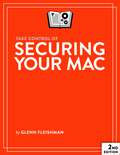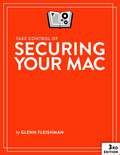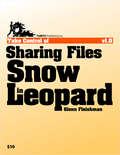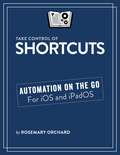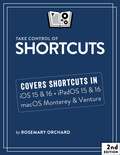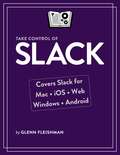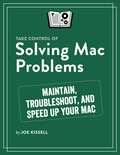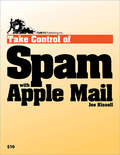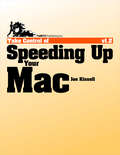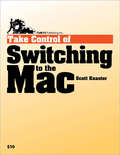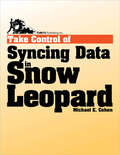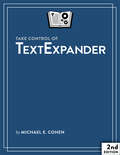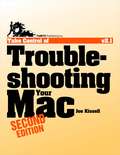- Table View
- List View
Take Control of Securing Your Mac
by Glenn FleishmanSecure your Mac against attacks from the internet and physical intrusion with the greatest of ease. Glenn Fleishman guides you through configuring your Mac to protect against phishing, malware, network intrusion, social engineering, and invaders who might tap physically into your computer. Glenn teaches how to secure your data at rest and in motion. Learn about built-in privacy settings, the Secure Enclave, FileVault, sandboxing, VPNs, recovering a missing Mac, and much more. Covers Ventura and Monterey.
Take Control of Securing Your Mac
by Glenn FleishmanSecure your Mac against attacks from the internet and physical intrusion with the greatest of ease. Glenn Fleishman guides you through configuring your Mac to protect against phishing, malware, network intrusion, social engineering, and invaders who might tap physically into your computer. Glenn teaches how to secure your data at rest and in motion. Learn about built-in privacy settings, the Secure Enclave, FileVault, sandboxing, VPNs, recovering a missing Mac, and much more. Covers Sonoma and Ventura.
Take Control of Sequoia
by Joe KissellmacOS 15 Sequoia is one of Apple's most ambitious updates in years. Along with the usual range of new features, it introduces Apple Intelligence, which will permeate many parts of the system and fundamentally change the sorts of things you can do with your Mac and how you do them. This book is your complete guide to what's new in Sequoia—and what Apple has planned for future updates, too.
Take Control of Sharing Files in Snow Leopard
by Glenn FleishmanRead this book to learn the answers to questions like: Which technique should I use to share my files? How do I set up my Mac as a file server? What types of security should I set up? Do I need a firewall? Should I use Samba or AFP as my file-sharing service? How can I restrict what users can do after they log in? How can my Windows-using colleagues access my shared files? How do I share iPhoto photos? What about songs from iTunes? What's the best way to connect to a file server from my Mac? What are my security options for running an FTP server? How can I configure my server so it wakes up if someone wants to use it?
Take Control of Shortcuts
by Rosemary OrchardAutomation is no longer just for advanced Mac and PC users! Apple's Shortcuts app lets anyone with an iPhone or iPad automate day-to-day tasks, from the simple to the complex. This book is a complete introduction to Shortcuts, which covers every aspect of building, installing, debugging, running, syncing, and sharing shortcuts. It also includes step-by-step recipes for creating numerous useful shortcuts yourself.
Take Control of Shortcuts
by Rosemary OrchardAutomation is no longer just for advanced computer users! Apple's Shortcuts app lets anyone with an iPhone, iPad, or Mac automate day-to-day tasks, from the simple to the complex. This book is a complete introduction to Shortcuts, covering every aspect of building, installing, debugging, running, syncing, and sharing shortcuts. It also includes step-by-step recipes for creating numerous useful shortcuts yourself.
Take Control of Siri
by Scholle McFarlandMake the most of Apple's digital assistant!Siri, Apple's voice-controlled digital assistant, has been around since 2011, when it debuted on the iPhone. But since then, it has become vastly more powerful and useful, and has spread across Apple's entire ecosystem--it now runs on iOS, macOS, Apple Watch, Apple TV, and HomePod. Siri can now listen and speak in a wide range of languages and accents, perform a long list of helpful day-to-day tasks, and keep you entertained in the process.Although Siri is easy to use, it's so multitalented that you might easily overlook some of its best features. In this book, former Macworld editor Scholle McFarland takes you deep into Siri's capabilities. You'll learn tons of tips and tricks about making the most of Siri. Discover how Siri can increase your efficiency and productivity, lend a hand when you're in the car or out for a jog, and even make it simpler to play music or find movies and TV shows to watch.Among many other things, this book teaches you:What hardware and software you need to use SiriHow to change Siri's language and voiceWays to personalize Siri by telling it about yourself, your contacts, and moreThe numerous ways to activate Siri (by touch or by voice)How to use Siri with AirPods, wired earbuds, or third-party headphonesWhat to do if the wrong device answers your "Hey Siri" requestHow to ask Siri about sports, math and conversions, time, food, movies, people, stocks, the weather, jokes, and random factsTips for asking Siri follow-up questionsHow to control music (on any device, with or without an Apple Music subscription)Techniques for using Siri to get directions, set reminders and appointments, send messages and email, and take notesWays to use Siri to search for files on your MacWhat Siri can and can't do for you on an Apple TV or HomePodHow to make and use Siri Shortcuts on an iOS device or Apple WatchEverything you need to know about your privacy where Siri is involvedPlus bonus videos! Since Siri is an audio-based, interactive tool, there are some things that are more readily demonstrated than written about. So Scholle has put together a series of videos that illustrate techniques from her book, allowing you to see and hear exactly what happens as you use Siri.Whether you're new to Siri or a seasoned pro, you're sure to find lots of tricks and suggestions in this book to improve your experience of using Siri.
Take Control of Siri
by Scholle McFarlandWhen it comes to using your Apple devices, Siri is increasingly the hands-free, time-saving, and fun technology that ties everything together. Whether you want to ask a question, make a call, find your iPhone, or set a timer—not only can Siri do it, but it usually offers the fastest way. This book explores how to get the most out of Siri on your iPhone, iPad, Apple Watch, Mac, and HomePod.
Take Control of Siri
by Scholle McFarlandWhen it comes to using your Apple devices, Siri is increasingly the hands-free, time-saving, and fun technology that ties everything together. Whether you want to ask a question, make a call, find your iPhone, or set a timer—not only can Siri do it, but it usually offers the fastest way. This book explores how to get the most out of Siri on your iPhone, iPad, iPod touch, Apple Watch, Mac, and HomePod.
Take Control of Siri
by Scholle McFarlandWhen it comes to using your Apple devices, Siri is the hands-free, time-saving, and fun technology that ties everything together. Whether you want to ask a question, make a call, find your iPhone, or set a timer, not only can Siri do it, but it usually offers the fastest way. This book explores how to get the most out of Siri on your iPhone, iPad, Mac, Apple Watch, Apple TV, and HomePod.
Take Control of Slack
by Glenn FleishmanMaster Slack for work and fun!The Slack group messaging system has become an integral part of work life (and even social life) for millions of people. It's a feature of the modern business landscape, but how can you make the best use of this powerful, 21st-century tool to both get your job done and have fun? In this book, Glenn Fleishman addresses every major type of Slack user:New user: If you're interested in or tempted by Slack but have never used it, this book will help you get up to speed quickly.Experienced user: If you use Slack already and want to get more out of it, this book will guide you to more efficient and more sophisticated use and control.Reluctant user: If Slack is a requirement for your workplace, nonprofit group, or other organization, this book will help you overcome frustration and confusion.Slack can make your work life better. This book helps you master Slack! It shows you things you'll never learn by reading the online documentation or simply poking around, based on Glenn's years of experience in multiple Slack teams.Among the many questions this book answers are:How do I get started using Slack, including creating my first workspace?How can I manage the number (and manner) of notifications I get on my desktop and on my mobile devices?Is there any way to edit the message I just posted so I can fix a mistake?How do I find other channels in my Slack workspace--or make new ones?How do I make audio or video calls in Slack, or use screen sharing?What are the differences between direct messages and public messages in Slack?How much privacy can I expect in Slack from coworkers, bosses, owners, and Slack itself?How much can I do in Slack for free? What features make sense to pay for?How do people find and enter emoji in messages?What does it mean when names in the sidebar are bold or italic?What do the numbers next to channel or conversation names indicate?What exactly is Slackbot, and why is it talking to me?How do I perform advanced searches to find what I need?How do I find and install Slack apps?Take Control of Slack replaces two previous titles: Take Control of Slack Basics and Take Control of Slack Admin. Although this new book borrows some elements from its predecessors, it's a brand-new, completely rethought guide that's up to date with the latest versions of Slack (right down to its brand-new icon!).
Take Control of Slack
by Glenn FleishmanWrap your head around how Slack group messaging works, learn to communicate and collaborate using its many features, and discover how to use integrations and notifications to get more out of it. The book explains finding channels, starting conversations, posting messages, interacting with bots, and more! The Slack web app is covered, along with apps for macOS, Windows, iOS, and Android.
Take Control of Solving Mac Problems
by Joe KissellMacs are generally quite reliable computers, but things still can and do go wrong. When you encounter an error message, an ornery app, or other unwanted behavior, don't panic. Take a deep breath and turn to the expert advice in "Take Control of Solving Mac Problems."
Take Control of Sonoma
by Joe KissellmacOS 14 Sonoma makes your Mac more secure and easier to use, with a wide array of new and improved features. Learn how to upgrade your Mac from an earlier version of macOS, find your way around Sonoma, use new features, and discover extensive changes to built-in apps such as Safari and Messages.
Take Control of Spam with Apple Mail
by Joe KissellQuestions answered in this book include: How does Mail's Junk Mail filtering really work? How does the spam filter use my Previous Recipients list? How could a spammer's email addresses get on my Previous Recipients list? What can I do to not get so much spam in the first place? What's the deal with email that pretends to come from my bank? What features should I look for in a spam-fighting utility or service? Should I try server-based filtering?
Take Control of Speeding Up Your Mac
by Joe KissellWith this 204-page book, you can: Save money: Extend your Mac's useful life and postpone buying an expensive new computer. Save time: Work more efficiently rather than constantly waiting for your Mac to catch up with you. Eliminate irritations: Banish the spinning pizza of death. Reduce startup and application launch times. Work smarter: Learn power user tricks for getting more done with less effort. You'll learn answers to questions like: What are the eight quickest fixes for Mac performance problems? Which common claims about Mac performance are myths? How can I objectively measure my Mac's performance? Which popular Mac OS X features have hidden (and severe) speed penalties? What are the best ways to find and eliminate CPU and RAM hogs? Can I make my Mac faster by freeing up disk space? Will defragmenting my disk, repairing permissions, or clearing caches speed up my Mac? When is an SSD (solid-state drive) a smart upgrade choice? Which hardware upgrades are worth the money, and which should I avoid? If Web browsing is slow, how can I tell where the bottleneck is? How can I make my Mac start up, go to sleep, or wake up faster? How can I type faster? How can I make my mouse pointer move faster or more fluidly?
Take Control of Speeding Up Your Mac
by Joe KissellDon’t settle for a sluggish Mac! If it seems your Mac has become slower and less responsive over time, it’s not your imagination—but it’s also a problem you can solve without buying a new computer. This comprehensive book teaches you how to find the exact causes of slow performance and take steps to make your Mac zippy again.
Take Control of Speeding Up Your Mac (2.0)
by Joe KissellDon’t settle for a sluggish Mac! If it seems your Mac has become slower and less responsive over time, it’s not your imagination—but it’s also a problem you can solve without buying a new computer. This comprehensive book teaches you how to find the exact causes of slow performance and take steps to make your Mac snappy again.
Take Control of Spotlight for Finding Anything on Your Mac
by Sharon ZardettoYou'll learn these search-related techniques: Improve search accuracy by limiting Spotlight to searching just where you want. Reduce result clutter by choosing which categories should appear in the Spotlight menu. Learn what to do when the Spotlight menu doesn't list an item that it should be able to find. Use criteria bars (and even the elusive Boolean bars!) to create complex search queries. Bypass criteria bars by typing complex, powerful queries in any Spotlight search field. Build Boolean searches with AND, OR, and NOT to narrow your search results precisely. In addition, you'll find out how to make your files even easier to find with these techniques: Customize a file's metadata. Employ free third-party utilities to give your files useful, searchable tags. Set up sophisticated smart folders that provide dynamic file organization. In these days of terabyte drives, your Mac has enormous storage capacity, and you may have many thousands of files squirreled away (we don't even want to admit to how many hundreds of thousands of files are filling up our disks!). But with the Spotlight expertise you'll gain from this ebook, you'll be able to retrieve anything on your Mac, no matter how deeply it's buried or how specific you need to make your search (how about every GarageBand song in the key of E-flat, or every graphic that's smaller than 500 by 500 pixels?).
Take Control of Switching to the Mac
by Scott KnasterSwitching to the Mac is easier than ever with our real-world advice! You're using Windows, so we're guessing that you're considering a switch to the Mac (good for you!) or that you're a Mac user on a PC at work. (If the latter, you may want to read the Mac-user version of this page.) There has never been a better time to switch to the Mac, but it's easier said than done. Never fear, because Scott Knaster, an alumnus of both Apple and Microsoft, has written a concise guide to speed you on your way. He starts by showing you what's cool about the Mac and how you can work around any troublesome bits, and, if you haven't already picked a Mac, he helps you choose among the different models. Then it's into the nitty-gritty, where Scott explains how to set up your Mac and navigate the Macintosh interface before clarifying which Mac applications replace familiar Windows programs and how to move your data to the Mac, including documents, email messages, address books, music, and Web bookmarks. Once you're set up, Scott helps you learn the basics of using the Mac, including how to set up multiple users, work effectively in Finder windows, search with Spotlight, manage applications and windows, use the network, print, download software updates, and more. As a bonus, you'll learn five Mac features you can't live without and find five more useful tips to help you become a power user. Finally, Scott has some advice if you must share documents with Windows users or run the occasional Windows application. This book covers the steps needed to switch your computing life from Windows to the Macintosh. It covers a lot of ground and by the end, you'll be running on your Mac with your files moved over from your Windows PC, and you'll know how to get around on your new Mac.
Take Control of Syncing Data in Leopard
by Michael E CohenIs your data stuck on your Mac? Learn how to sync it with another Mac, iPhone, iPod, mobile phone, or PDA! With clear directions and a humorous touch, Take Control of Syncing Data in Leopard explains how to sync data from a Mac running Mac OS X 10.5 Leopard with a variety of devices from Apple and other companies. Whether you want to sync phone numbers between your Mac and your mobile phone, share calendars and keychains between Macs, or move only new podcast episodes to a small iPod, syncing expert and master punster Michael Cohen has the answers. You'll learn what software and gear you need and the best ways to move data between different devices. The ebook also explains how syncing works under the hood and provides troubleshooting advice in case your sync engine throws a rod. Types of sync data covered include:Calendar items stored in iCal, Entourage, and Google Contacts stored in Address Book, Entourage, Yahoo, and Google Data on Exchange servers Dock items and Dashboard widgets Apple Mail account settings, Safari bookmarks, and application preferences Apple Mail and Entourage notes Keychains (user names and passwords) Items from software that uses Leopard's Sync Services, including NetNewsWire and Yojimbo Audio, video, photos, and associated metadata from iTunes Types of devices covered include:Macs, with details on MobileMe and overviews of popular third-party options iPhone and iPod touch, via MobileMe or iTunes Old and new iPods via iTunes, with details on USB and FireWire connections The Apple TV via iTunes Mobile phones, smartphones, BlackBerries, and Palm OS PDAs
Take Control of Syncing Data in Snow Leopard
by Michael E CohenYou'll learn about syncing managed data on a Mac running Snow Leopard with:Another Mac Microsoft Exchange The cloud (i.e. MobileMe or Google) An iPhone, iPod, or Apple TV A non-Apple mobile phone A PDA (i.e. a Palm or Blackberry, specifics are brief) Types of sync data covered include:Calendar items stored in iCal, Entourage, Google, and Yahoo Contacts stored in Address Book, Entourage, Google, and Yahoo Data on Exchange servers Data on MobileMe Dock items and Dashboard widgets Apple Mail account settings, Safari bookmarks, and application preferences Apple Mail and Entourage notes Keychains (user names and passwords) Items from software that uses Mac OS X's Sync Services, such as Yojimbo Audio, video, photos, apps, and associated metadata from iTunes Types of devices covered include:Macs, with details on MobileMe and overviews of popular third-party options The iPhone and iPod touch, via Microsoft Exchange, MobileMe, or iTunes Old and new iPods via iTunes, with details on USB and FireWire connections The Apple TV via iTunes Mobile phones, smartphones, BlackBerries, and Palm OS PDAs via iSync and/or third-party utilities Connection technologies and software examined include:Bluetooth, USB, FireWire, Wi-Fi, and Ethernet MobileMe, iTunes, iSync, IMAP (IMAP discussion is limited to Apple Mail), Exchange Third-party products from BusyMac, Feisar, Mark/Space, Nova Media, PocketMac, and Spanning Sync Sampler of special questions you'll find answers to: What is the truth database? And what should I do if I think it's lying? When a sync occurs, what's going on behind the scenes? What is push syncing and how does it work? What is the difference between syncing and a backup? What does Bluetooth "discovery" mean, and what should I do about it? Can I control exactly which audio and video files sync to my iPod? How do I override automatic syncing when I connect my iPod to iTunes? How does iTunes decide if a video file is a movie, TV show, or music video? How does the Apple TV figure out what to sync if it fills up? How do I sync everything possible to my iPhone--calendars, contacts, Safari bookmarks, the works? How do I sync a mobile phone that Apple doesn't support? Argh! Snow Leopard's iSync doesn't support the Palm! What third-party software can I use instead? I want to sync directly with an Exchange server... what do I need to know? What's the smartest way to sync keychains between Macs? I have a syncing feeling about my data--what should I do?
Take Control of TK
by Glenn FleishmanThe digital and “real” worlds can both be scary places. The smartphone (and often smartwatch) you already carry with you can help reduce risks, deter theft, and mitigate violence. This book teaches you to secure your hardware, block abuse, automatically call emergency services, connect with others to ensure you arrive where and when you intended, detect stalking by compact trackers, and keep your ecosystem accounts from Apple, Google, and Microsoft secure.
Take Control of TextExpander
by Michael E CohenRunning TextExpander is like embedding a superhero typist in your Mac. Read Take Control of TextExpander to learn how to: Reply faster: If you frequently send similar bits of text--directions, chunks of legal writing, bios, product descriptions, company names, addresses, URLs, and so forth--let TextExpander quickly type all that text for you, making it a snap to respond quickly to customer questions or requests from colleagues, and a breeze to send other routine correspondence ("Dear Mom, I'm still not pregnant. Love, Me"). You can even create fill-in snippets that ask you for details and fill in all the rest of the text automatically. Make typing more exciting: Discover how to grab and insert the URL in your browser's frontmost window into whatever you're writing, to insert HTML or CSS tags in a flash, to automagically add the date to filenames as you save, and more. It's like having another set of fingers. Type more accurately: Find out how to add the auto-correct dictionary groups from Smile and to create your own auto-correction options, so you'll spend less time fixing common typing mistakes or going red-faced when you spot an egregious error too late. Enjoy life more: When you let TextExpander handle your routine typing, your brain will be free to think more creatively about the rest of what you type. And you just might knock off work a little sooner some days. Specific questions answered in this ebook include: How do I register my demo copy of TextExpander and buy a family pack? What are some common uses of TextExpander that I can try as I learn? How do I use TextExpander to timestamp my text automatically? How can I put the clipboard contents into an expanded snippet? How can I make a TextExpander snippet that expands into a fill-in form? How do I work with formatted text and pictures in snippets? How do I handle capitalization and snippet expansions? How can I get to TextExpander quickly, and hide it when I don't need it? What do I do if I can't remember a snippet's expansion abbreviation? How can I edit my snippets quickly? How can I quickly insert special characters like smileys and stars? How do I insert a snippet and move the insertion point into the middle of it? How do I insert a snippet immediately after a quotation mark or bracket? I do a lot of CSS coding. TextExpander sounds great, but how can I leverage someone else's work and not have to create my own set of CSS expansions? How can I invoke an AppleScript from within a TextExpander snippet expansion, and use the result in my snippet?
Take Control of Troubleshooting Your Mac
by Joe KissellThe 17 basic troubleshooting procedures (along with the reasons why they can help) you'll learn are: Restart your Mac Force-quit an application Start up from another volume Run disk-repair utilities Erase and restore from backup Repair permissions Start up in safe mode Turn off login items Check preference files Reset PMU, SMU, SMC, NVRAM, or PRAM Use Activity Monitor Check free disk space Check log files Clear caches Check your RAM Test for reproducibility Get system information Joe also explains how to solve 15 common problems, including: Your computer won't turn on Your computer keeps turning itself off You experience repeated kernel panics Your Mac is abnormally slow You can't empty the Trash An application grinds to a halt An application crashes The keyboard or mouse doesn't work You lose your Internet connection Printing doesn't work Spotlight searches fail Keychain (seemingly) forgets passwords Apple Mail fails to connect Time Machine misbehaves A volume won't unmount
